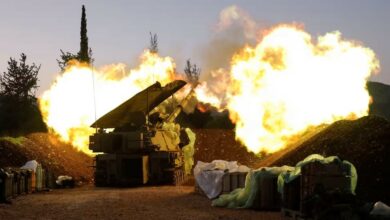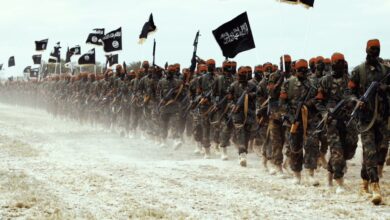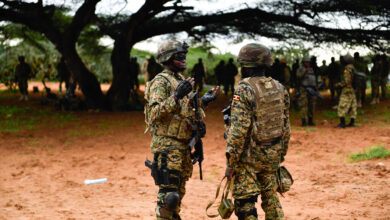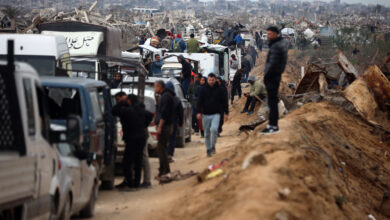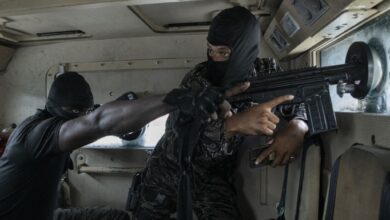United Nations troops and an armed group exchanged gunfire overnight near the president’s residence in the Central African Republic, a security source said Monday.
“There was an attack lasting about half an hour, which singled out MINUSCA,” mission spokesperson Vladimir Monteiro told AFP.
“We are checking who was behind the attack. We returned fire and sent reinforcements. The attack was not directed against a CAR institution,” Monteiro said.
The security source said the exchanges late on Sunday took place after an armed group arrived “by the Ndeke Luka radio station by the road that leads to the residence” of President Faustin-Archange Touadera.
“The group was repulsed by U.N. peacekeepers from Egypt,” the source said.
The assailants came by motorbike and in a fake U.N. vehicle, a local resident said.
The attack in the institutional district of Bangui is the first such incident since Touadera was elected in 2016.
The incident came hours after U.N. and Central African forces launched a joint operation targeting armed groups in a mainly Muslim district of the city. At least two people were killed and dozens wounded during the joint operation, according to U.N. and medical sources.
Joint operation in PK5
Herve Verhoosel, a spokesperson for the U.N. peacekeeping force, Minusca, said 11 peacekeepers, mostly Egyptian, were among the injured in Sunday’s joint disarmament and arrest operation.
Minusca said the joint force raided the bases of several groups, resulting in the seizure of arms, ammunition, and drugs.
Eight people belonging to the armed groups Force and 50/50 had been detained, Verhoosel told AFP, adding that the operation will continue “until the goal is achieved.”
“The PK5 is the economic lung of Bangui and must remain so,” said Verhoosel, comparing the armed groups to the Italian mafia.
The operation followed a resurgence in violence in the flashpoint PK5 neighborhood in Bangui.
On April 1, U.N. peacekeepers exchanged fire with members of an armed group in PK5, the first attack on U.N. troops since violence resumed in the neighborhood in 2017.
“These attacks … show the criminal nature of the groups who have taken up arms in the PK5 area,” said Verhoosel, adding that the leader of the group in question has “told the media that they would attack peacekeepers.”
Days earlier, Nimery Matar Jamous – known as “Force” – the leader of the main “self-defense” group in PK5, threatened Minusca, telling AFP that “if the U.N. blue helmets want a war, they only have to tell residents to leave the area and we will defeat them.”
In February a trade group in the area reportedly urged Minusca to deal with armed groups, accusing them of intimidation and of extorting protection money.
Minusca said it would dismantle all the armed groups’ bases unless they hand over their weapons, according to AFP sources. Minusca says the leaders of the groups’ leaders refused, despite a mediation organized by community leaders.
“This joint operation will continue until the criminal groups of PK5 are dismantled or otherwise disappear,” Minusca said.
Self-defense groups in PK5
PK5’s population was previously supportive of the armed groups, which sprung from a desire to protect their neighbourhoods as the country spiralled into civil war.
In March 2013, Séléka, a mainly Muslim alliance, overthrew CAR’s leader Francois Bozizé – a rebel leader and former army commander who seized power in 2003 – unleashing a spiral of violence between Muslim and Christian militias in which thousands died.
Bozize fled the country and was later indicted for crimes against humanity and incitement of genocide.
After Bozize was ousted, former army members joined the anti-balaka militia to fight the Seleka rebels.
A mainly-Christian group, the anti-balaka began as a number of local self-defense groups before joining forces in 2012, according to GlobalSecurity. The term refers to the balaka machetes used by Seleka rebels.
Michel Djotodia took over as president in 2013, and his prime minister Nicolas Tiangaye requested a U.N. peacekeeping force. By August 2013, there were reports of over 200,000 internally displaced persons in the country.
In September 2013, Seleka officially disbanded, but many fighters refused to disarm, becoming known as ex-Seleka. Some argue that disarmament efforts focused on the Seleka and gave the anti-balaka the upper hand, leading to the forced displacement of Muslim civilians by anti-balaka in Bangui and western CAR.
In January 2014, Djotodia and Tiengaye resigned and Catherine Samba-Panza was elected as interim president. That July, Seleka and anti-balaka representatives signed a ceasefire agreement in Brazzaville. By the end of 2014, the country was de facto partitioned – anti-Balaka in the southwest and ex-Seleka in the northeast.
Muslims either fled the capital or took refuge in PK5, where the population funded the creation of their own self-defence groups, most of whom were former Seleka rebels, to defend from constant anti-balaka vigilante attack.
The weak government only controls around a fifth of the Central African Republic. The rest of the territory is controlled by militia groups – some of which are nominally pro-Muslim or pro-Christian – that often fight each other for control over the country’s mineral wealth.
Although rich in diamonds, gold, oil and uranium, the former French colony has one of the world’s poorest populations, and has been blighted by violence and instability since gaining independence in 1960.
Faustin-Archange Touadera, a former prime minister who campaigned as a peacemaker, was declared the winner of a 2016 presidential election perceived as crucial to transitioning from years of sectarian violence.
United Nations Multidimensional Integrated Stabilization Mission in the Central African Republic
The U.N.’s Minusca mission was launched in 2014 and its primary mandate is to protect civilians. Minusca is also charged with supporting the transition and extension of justice and the rule of law, facilitating humanitarian assistance, promoting and protecting of human rights, and disarmament, demobilization, reintegration and repatriation processes.
According to a February report to the U.N. Security Council, Minusca had deployed 10,665 military personnel, 90 percent of the total authorized strength of 11,650. The deployment includes 11 infantry battalions, a special forces company, a quick-reaction force company, three helicopter units, including a combat helicopter unit, an unmanned aerial vehicle unit among other.
Minusca also deployed 2,044 police personnel out of a total authorized strength of 2,080, and 1,390 civilian personnel, 80 percent of the total of 1,747 authorized positions.
Deadly attack on UN Minusca peacekeepers
On April 2, U.N. peacekeepers “peacefully recovered” 23 people, including 13 women and three children held by ex-Seleka rebel group Union for Peace in Central Africa (UPC) in Tagbara, near the southern city of Bambari.
They sheltered overnight at the temporary U.N. base in Tagbara.
The Tagbara base came under heavy attack from anti-balaka militia at 5 a.m. One U.N. peacekeeper from Mauritania was killed and 11 others were wounded and more than 22 anti-balaka fighters were killed.
Minusca said it later discovered the bodies of 21 civilians, including four women and four children, near a church, and that the deaths resulted from a separate incident that used “traditional weapons,” indicating machetes or knives.
Days earlier, U.N. peacekeepers carried out a joint operation with CAR forces to rescue 15 people who had been taken hostage in the village of Koumbou by the Lord’s Resistance Army.
African Union talks
Also on April 2, envoys from the African Union finished a round of meetings with militia groups aimed at setting conditions for round-table talks between armed groups and the government under an “African peace initiative” for the CAR adopted last July.
“We have just met the RJ [Revolution Justice] group in Paoua in the northwest. It promised to work together with the panel toward the round table which will be organised,” Moussa Nebie, the A.U.’s representative in CAR and head of the panel, said.
The A.U. facilitators said they had met the 14 recognised armed groups in all, and the round-table talks would begin in “a few weeks.”
The A.U. initiative is the fourth to have been attempted in less than four years.
With reporting from AFP




